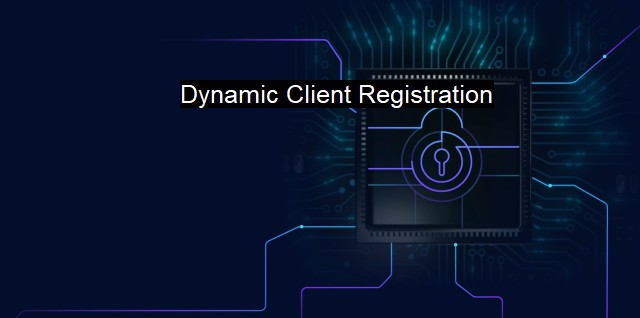What is Dynamic Client Registration?
The Advantages of Dynamic Client Registration (DCR) for Agile and Secure OAuth Authentication
Dynamic Client Registration, or Dynamic Registration, is a security function that supports client applications to interact with authorization servers and fosters security compliance within Software as a Service (SaaS) applications and cloud services. Dynamic registration works by allowing automated registration of a client application with an authorization server, thereby boosting the efficiency and safety of digital platforms and systems.In the domain of cybersecurity and antivirus, Dynamic Client Registration plays an integral part in maintaining the foreground of secure authorization. The cybersecurity environment needs robust communication processes that can deter possible security threats. Hence, the requirement of having a process like Dynamic Client Registration comes into play. In simple words, it acts as a bridge between the client applications and the server, avoiding unauthorized access and potentially harmful activities.
A better understanding of how Dynamic Client Registration operates involves approaches such as OAuth 2.0, which dictates standards for secure access to web APIs. An OAuth 2.0 protocol is responsible for creating secure and effective connections between the third-party application (client) and the authorization server. This protocol provides two registration methods: static and dynamic. Static registration requires manual client registration, whereas dynamic registration is an automated process that offers increases in scalability and efficiency by permitting software developers to register their applications automatically.
Dynamic Client Registration offers various benefits. Fundamentally, it adds a layer of protection in the cybersecurity field by allowing only registered or authorized clients to access the servers. This cautionary mechanism reduces the chances of security breaches, cyberattacks, and unauthorized access.
Dynamic Client Registration aids in preventing malware spread and potential virus infections. Since unauthorized access is drastically mitigated, the risk of malicious code injection is also considerably reduced. In this context, client apps or ecosystems using dynamic registration are less probable targets of attacking attempts, as the process safeguards against cyber hazards like Distributed Denial of Service (DDoS) attacks.
Dynamic Client Registration also supports the scalability of compatible apps and systems. The automatic registration process lends itself to situations involving an uncountable number of software applications, making it a perfect fit in the vastness of today’s digital landscape. For instance, large companies with thousands of applications collaborating with servers can profit from the dexterity offered by such an automatic operation.
Advanced dynamic registration systems provide mutual TLS client certificate-bound access tokens. What this means in the realm of cybersecurity is that each access token is bound to the client’s TLS sessions, introducing an extra security layer against malevolent actors. The use of such a security feature in antivirus and cybersecurity applications can be elemental to secures both application-based as well as server-based data and information.
In the changing realms of cybersecurity and antivirus applications, Dynamic Client Registration serves as a crucial toolkit for developers, administrators, and security experts, delivering consistency, efficiency, and security across digital infrastructures and ecosystems. Comprehensive risk mitigation substantially depends on more than just securing servers and operating systems; it involves shielding applications and quarantining the space they function in from potential threats.
Dynamic Client Registration in the context of cybersecurity and antivirus proves to be pivotal. As software development, cyberspace specifications, and digital capabilities expand and evolve, so too must defence mechanisms that protect against cyber threats. The combination of simplicity and efficiency with an added layer of protective assurance makes Dynamic Client Registration an integral part of comprehensive information systems security.

Dynamic Client Registration FAQs
What is dynamic client registration in the context of cybersecurity and antivirus?
Dynamic client registration is a process where software programs can register themselves automatically with an external server without requiring any manual intervention. In cybersecurity and antivirus, this feature can be used to securely identify and manage client devices, such as computers or smartphones, and ensure their compliance with security policies.Why is dynamic client registration important in cybersecurity and antivirus?
Dynamic client registration is essential in cybersecurity and antivirus because it enables organizations to keep track of all devices connected to their network and ensure that they meet the necessary security requirements. This helps to prevent unauthorized access and reduce the risk of cybersecurity threats, such as malware or viruses.How does dynamic client registration work in antivirus software?
In antivirus software, dynamic client registration typically involves the installation of an agent on the client device. This agent then communicates with the antivirus server and registers the device, providing information such as its name, operating system, and antivirus software version. The server can then use this information to enforce security policies and push updates or patches as necessary.What are some of the benefits of using dynamic client registration in antivirus software?
Some of the primary benefits of using dynamic client registration in antivirus software include improved security, better device management, and reduced administrative overhead. By allowing devices to register themselves automatically, organizations can ensure that all devices are up-to-date with the latest security patches and policies. This can help to prevent security breaches and reduce the workload for IT administrators who would otherwise have to manually manage each device on the network.| | A | | | B | | | C | | | D | | | E | | | F | | | G | | | H | | | I | | | J | | | K | | | L | | | M | |
| | N | | | O | | | P | | | Q | | | R | | | S | | | T | | | U | | | V | | | W | | | X | | | Y | | | Z | |
| | 1 | | | 2 | | | 3 | | | 4 | | | 7 | | | 8 | | |||||||